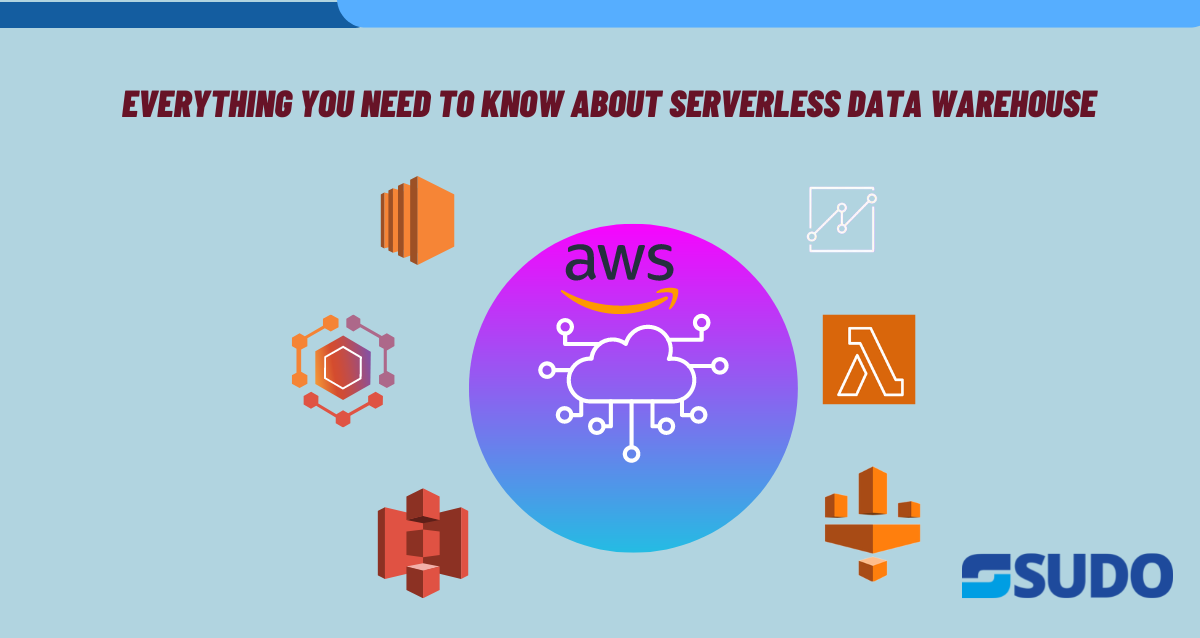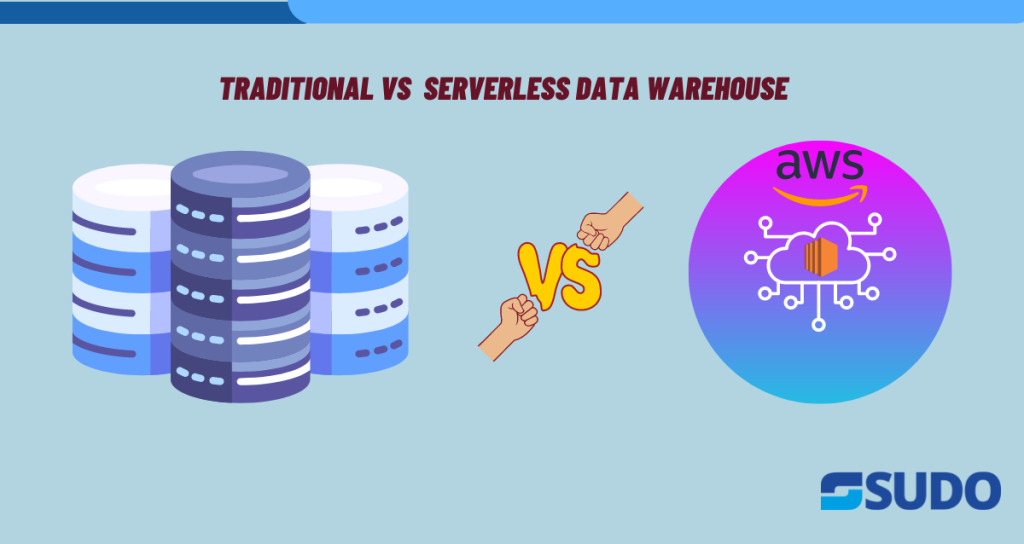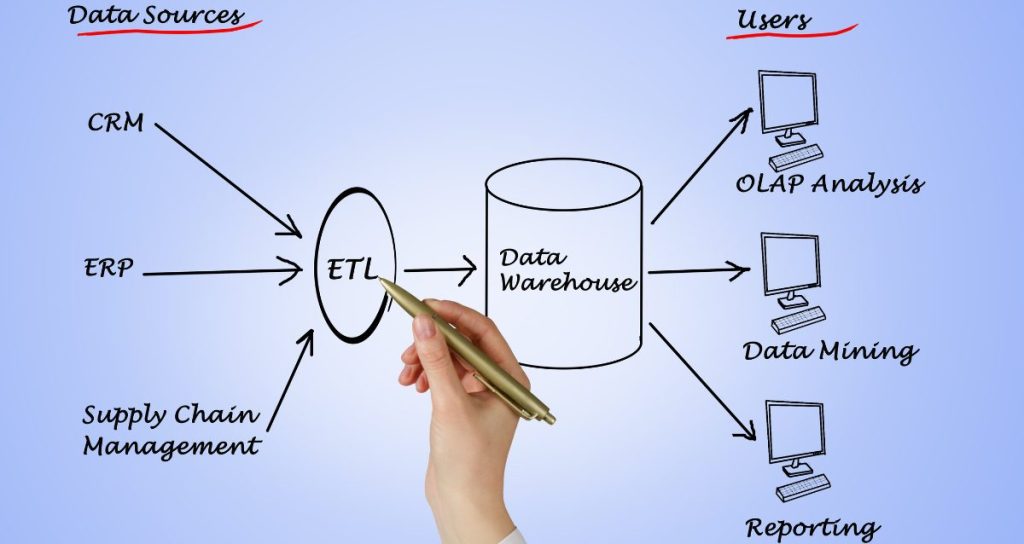
A serverless data warehouse is a type of data warehouse that does not require the user to provision, scale, or manage servers. Instead, the user only pays for the amount of storage and computational resources they use, and the provider is responsible for managing and scaling the infrastructure.
The most popular serverless data warehouse services are offered by cloud providers such as AWS, Azure, and Google Cloud. These services generally provide automatic scaling, which allows them to handle sudden spikes in data volume, and they are typically pay-per-use, which can lead to significant cost savings.
Traditional Data Warehouse VS Serverless Data Warehouse

Serverless data warehouses and traditional data warehouses are both types of data warehouses that are used to store and manage large amounts of data, but they have some key differences:
- Serverless data warehouses do not require the user to provision, scale, or manage servers, while traditional data warehouses require the user to do so.
- Serverless data warehouses typically have lower costs and are more flexible and scalable than traditional data warehouses. They also offer automatic scaling, which allows them to handle sudden spikes in data volume. However, traditional data warehouses may offer more advanced features and greater control over the data and infrastructure.
- Serverless data warehouses are designed to handle large amounts of data and provide high performance, which is critical for data-intensive workloads. Traditional data warehouses may not be optimized for high performance and scalability.
- Serverless data warehouses are typically hosted on cloud platforms, like AWS, Google Cloud, Azure, etc. Traditional data warehouses can also be hosted on-premises or in a private cloud.
- Serverless data warehouses are generally easy to set up and use, with minimal administrative overhead. Traditional data warehouses can be more complex to set up and manage, requiring specialized skills and knowledge.
Why should you chose AWS for building Serverless Data Warehouse
There are several reasons why you may choose a serverless data warehouse on AWS:
- Cost-effective: Serverless data warehouses on AWS, such as Amazon Redshift, are pay-per-use, meaning you only pay for the resources you use. This can lead to significant cost savings, especially for organizations with varying workloads.
- Automatic Scaling: Serverless data warehouses on AWS automatically scale to handle sudden spikes in data volume, eliminating the need for manual scaling and providing a more predictable cost structure.
- Flexibility: Serverless data warehouses on AWS allow you to easily and quickly spin up new resources as needed, providing greater flexibility and scalability than traditional data warehouses.
- Integration with other AWS services: AWS provides a wide range of services that can be easily integrated with a serverless data warehouse, such as data lake, data warehousing, analytics and machine learning to provide a full-fledged data analytics solution.
- Security and compliance: AWS provides a wide range of security and compliance capabilities, such as encryption and access controls, to ensure that your data is secure.
- High performance: AWS serverless data warehouses are designed to handle large amounts of data and provide high performance, which is critical for data-intensive workloads.
You can read this quick guide to make your own serverless Data warehouse.
5 insightful Design combinations of necessary aws services for you
To make aws serverless data warehouse from scratch, here is the list of 5 insightful combinations of necessary aws services for you :
- Amazon S3, Amazon Glue and Amazon Redshift: To create a serverless data warehouse from scratch, Amazon S3 can be used as a data lake to store raw data. Then, Amazon Glue can be used to extract, transform, and load the data into Amazon Redshift for analysis. Amazon Redshift can be used as a data warehouse to store and query the data in a serverless, pay-per-use manner.
- Amazon S3, AWS Glue and Amazon Redshift Spectrum: Similar to the first combination, Amazon S3 can be used as a data lake to store raw data, and AWS Glue can be used to extract, transform and load the data. However, Redshift Spectrum allows querying the data stored in S3, without having to load it into a Redshift cluster, making it more cost-effective and elastic.
- Amazon S3, Amazon Kinesis and Amazon Redshift: This combination is best suited for streaming data use cases. Amazon Kinesis can be used to capture, process, and stream the data in real-time. The data can then be loaded into Amazon Redshift for analysis.
- Amazon S3, AWS Lambda and Amazon Redshift: This combination uses AWS Lambda to run custom code (ETL or ELT) to process the data before loading it into Amazon Redshift. This is a useful option when you have specific requirements that can’t be met by Glue or other ETL tools.
- Amazon S3, Amazon QuickSight and Amazon Redshift: After loading the data into Amazon Redshift, Amazon QuickSight can be used to perform advanced analytics and create interactive visualizations of the data, all in a serverless, pay-per-use manner. This combination allows for the creation of rich dashboards and reports, providing insights and enabling data-driven decision-making.
Real-world use cases of Serverless Data Warehouses
- E-commerce: E-commerce companies are using serverless data warehouses to analyze customer data, such as purchase history and browsing behavior, to gain insights into customer behavior and improve marketing and sales efforts.
- IoT: Internet of Things (IoT) companies are using serverless data warehouses to store and analyze large amounts of sensor data from connected devices. This data can be used to gain insights into device usage patterns and improve product design and development.
- Financial Services: Financial services companies are using serverless data warehouses to analyze large amounts of financial data, such as stock prices and trading volumes, to gain insights into market trends and make better investment decisions.
- Healthcare: Healthcare organizations are using serverless data warehouses to store and analyze patient data, such as medical history and treatment outcomes, to improve patient care and develop new treatments.
- Manufacturing: Manufacturing companies are using serverless data warehouses to store and analyze data from sensors and other devices in the manufacturing process, in order to improve production efficiency and reduce costs.
- Gaming: Gaming companies are using serverless data warehouses to store and analyze player data, such as in-game behavior and purchases, to gain insights into player behavior and improve the gaming experience.
- Social Media: Social media companies are using serverless data warehouses to store and analyze large amounts of user data, such as posts, comments, and likes, to gain insights into user behavior and improve the platform’s offerings.
- Advertising: Advertising companies are using serverless data warehouses to store and analyze data on ad performance, such as views and clicks, to gain insights into ad effectiveness and improve targeting.
- Telecommunication : Telecommunications companies are using serverless data warehouses to store and analyze data from mobile devices, such as call and text logs, to gain insights into customer behavior and improve network performance.
- Supply Chain : Supply chain companies are using serverless data warehouses to store and analyze data from logistics, warehouse, and transportation operations, to gain insights into inventory, delivery times and costs, and improve supply chain efficiency.
These are just a few examples of how organizations are using serverless data warehouses in different industries and use cases.
Monitoring and managing a serverless data warehouse
Monitoring and managing a serverless data warehouse can be different from traditional data warehouse, due to the serverless architecture and cloud-based nature. Some best practices for monitoring and managing a serverless data warehouse include:
- Monitoring resource usage: Serverless data warehouses typically have automatic scaling, but it’s important to monitor resource usage to ensure that the data warehouse is running efficiently and to identify any potential issues. This includes monitoring CPU, memory, and storage usage.
- Performance tuning: It’s important to regularly monitor and tune the performance of a serverless data warehouse, including optimizing query performance and adjusting data distribution and compression settings.
- Backup and recovery: Serverless data warehouses typically handle backup and recovery automatically, but it’s important to monitor and test these processes to ensure that data is being backed up correctly and can be recovered in the event of a failure.
- Security and compliance: Serverless data warehouses typically provide built-in security and compliance features, but it’s important to monitor these features to ensure that they are configured correctly and that data is being protected in accordance with your organization’s security and compliance requirements.
- Logging and auditing: Serverless data warehouses typically provide built-in logging and auditing features, but it’s important to monitor and analyze these logs to identify any potential issues or security breaches.

Future of serverless data warehouses
The future of serverless data warehouses is likely to be influenced by several trends and developments, including:
- Advancements in Machine Learning and AI: Serverless data warehouses are expected to incorporate more advanced machine learning and AI capabilities, such as natural language processing and computer vision, to enable more sophisticated data analysis and insights.
- Real-time analytics: Serverless data warehouses are expected to provide more real-time analytics capabilities to enable real-time decision making and actions.
- Edge computing: With the increasing amount of data generated at the edge, serverless data warehouses will have to integrate with edge computing infrastructure to process and analyze data closer to its source.
- Multi-cloud and hybrid: Serverless data warehouses will increasingly have to support hybrid and multi-cloud environments, allowing customers to run their data warehouses on multiple cloud providers.
- More specialized data warehousing services: Cloud providers will likely introduce more specialized data warehousing services such as graph databases, time-series databases, and more specific data warehousing for specific industries like healthcare, retail, and more.
- More collaboration: Serverless data warehouses will increasingly provide more collaboration features, such as shared dashboards and workspaces, to allow users to work together more easily and effectively.
- More automation: Serverless data warehouses will become more automated, with features such as automatic indexing, query optimization, and data management, reducing the need for manual intervention.
- More secure: Serverless data warehouses will become more secure with features like data masking, row-level security, and dynamic data masking.
Long story short, future of serverless data warehouses looks promising, with new trends and developments expected to further improve the performance, scalability, security, and ease of use of these systems.
Limitations
There are also some potential drawbacks to using a serverless data warehouse. These include:
- Limited control: Since the infrastructure is managed by the provider, you may have limited control over certain aspects of the data warehouse, such as the underlying hardware.
- Limited advanced features: Some traditional data warehouses may offer more advanced features than serverless data warehouses.
- Cost: If you have a large amount of data, or very high query loads, the cost of a serverless data warehouse could be higher than traditional data warehouse
Conclusion
In conclusion, serverless data warehouses are a powerful and cost-effective way to store, process, and analyze large amounts of data. These data warehouses eliminate the need for provisioning, scaling, and managing servers, and instead provide automatic scaling and pay-per-use pricing. By using a serverless data warehouse, organizations can gain insights and make data-driven decisions, while also reducing costs and improving flexibility and scalability.
With the advancements in machine learning and AI, real-time analytics, edge computing, multi-cloud and hybrid environments, more specialized data warehousing services, more collaboration and automation, and more security, the future of serverless data warehouses looks promising.
However, it’s important to keep in mind that serverless data warehouses may not be the best solution for every use case and organization. It’s important to evaluate the specific needs and use cases of an organization, and weigh the potential benefits and drawbacks before deciding if a serverless data warehouse is the right choice.
By understanding the concepts and best practices for designing and building a serverless data warehouse, and by keeping an eye on the latest trends and developments in the field, organizations can take advantage of the many benefits of serverless data warehouses and gain a competitive edge in today’s data-driven world.